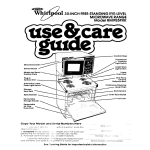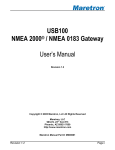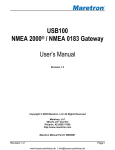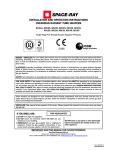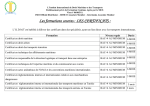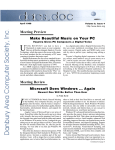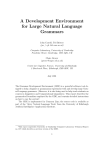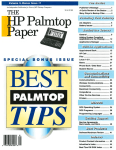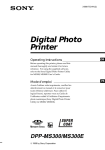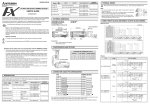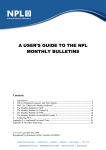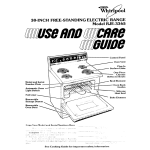Download INTEX atIBM - Université de Liège
Transcript
INTEX atIBM
Max SILBERZTEIN
Introduction
lNTEX is a development environment that allows users to rapidly
construct, test and maintain descriptions of specifie patterns that occur
in texts written in natural language.! Bach description is represented
by a local grammar, usually entered via the INTEX graph editor. Local
grammars (or graphs) can be used to represent:
- character-based patterns, for the recognition of phone numbers (e.g.
"sequence of 3 digits, followed by a space 01' an hyphen, folloll'ed
by 4 digits"), emai! or Internet addresses, hours or dates expressed
numerically, reference or seriai numbers, sentence endings, etc.
- orthographical patterns, for the recognition of spelling variants (e.g.
"centre or center"), company names and their variants ("International Business Machines COip., Big Blue"), etc.;
- morphological patterns, for the recognition of families of derived
words (e.g. "France, French, Frenchmen, ji'enchijj>") and inflected
fonns (conjugation of verbs, inflection of nouns);
- families of lexical entries, for the recognition and indexing of related tenns and concepts (e.g. "credit card, debit card, MasterCard,
visa card ...");
1 Sec an overview of the system in SILBERZTEL'l" 1999; the instl1lction mallual is
SILBERZTEIN
{8J
2000.
Max SILBERZTEIN, IBM T.J. \Vatson Research Center
e-mail: [email protected]
Extrait de la Revue Informatique et Statistique dans les Sciences humaines
XXXVI, 1 à 4, 2000. C.I.P.L. - Université de Liège - Tous droits réservés.
320
Max SILBERZTEIN
- morphosyntactic patterns, for the recognition of frozen or senufrozen expressions, such as complements of dates and times (e.g.
"on Monday the 15th at 3PM", "two days ago in the early afternoon"), of locations, addresses, etc.;
- other morphosyntactic patterns for the recognition and co-indexing
of tl'ansjorllled syntactic constructions (e.g. "No's trip to NI = No
went, traveled to NI")'
One important characteristic of IN TEX is that each local grammar
can be easily re-used in other local grammars. Developers typically
construct simple, elementm'y graphs that are equivalent to filute-state
transducers (FSTs), and re-use these elementary graphs to construct
more complex graphs. This process is sinular to the method by which
engineers build "black boxes" with Computer Aided Design systems
to design for instance simple logical operators (AND, XOR) that are
subsequently reused in elementary m·ithmetic operations (ADD), reused in Im'ge numbers ill more complex arithmetic operations (ADD64),
in ALUs, processors, etc. INTEX provides tools to help design, test,
debug, refine and maintain Im'ge numbers of local grammm's ID
libraries.
Another chm'acteristic of lNTEx is that ail the objects processed
(grammars, dictionaries and texts) are internally represented by FSTs.
Therefore, ail the functionalities provided by the system are expressed
as a linuted number of operations on FSTs. For instance, applying a
grammar to a text is pelformed by computing the muon of the
grammar FSTs, and then the intersection of the resulting FST and the
text FST. This architecture allows for very efficient algorithms (e.g.
when applying a determiJustic FST to indexed texts) and gives INTEX
the power of a Turing maclune (thanks to the ability to cascade FSTs).
At the T.J. Watson Resem'Cil Center, several groups are using
INTEX for different projects.
Textract (TALENT group, Roy Byrd)
The TALENT ("Text Analysis and Language ENgineering") group
has developed a series of text analysis tools that process document
collections to automatically feed databases that represent the domain
Extrait de la Revue Informatique et Statistique dans les Sciences humaines
XXXVI, 1 à 4, 2000. C.I.P.L. - Université de Liège - Tous droits réservés.
321
INTEX AT IBM
vocabulary, compute links between tenns and concepts that are used
to navigate withiu the documents, retrieve relevant information, compute summaries, etc.
Textrflct: extraction of vocabularies, relationships, and document
stmcture
SUlJll1larizer: extraction of salient sentences
TextLiller: inserting document highlights
Colltext Thesaul'IIs: find vocabulary items related to a query
Lexicaf Navigatioll: explore lexical networks
ProlJlpted Quel')' RejillelJlellt: suggest quelY improvements
TopCat: document categorization
These tools are based on the Textract program which processes
each individual document of the collection.
']f'md A!!fi:mtlysa§ l©(DJtl:!)
Textract
Fig. 1: The Textract pl'ogralll
Several of the Textract functionalities are based on finite state
recognizers that identify relevant items; each type of items corresponds to a specific program module:
SelltSep splits the text-file into tokens, sentences and paragraphs;
Extrait de la Revue Informatique et Statistique dans les Sciences humaines
XXXVI, 1 à 4, 2000. C.I.P.L. - Université de Liège - Tous droits réservés.
322
Max SILBERZTEIN
Text Patte1'll Recognizer recognizes simple sequences of characters
(phone numbers, dates expressed numerically, etc.);
Nominator recognizes single- and multi-word proper names of
persons, places and orgatùzations;
Terminator recogtùzes multi-word technical terms;
Abbreviator recognizes abbreviated tenns and acronyms, and links
them to their full form.
RAVIN & KAZl 1999 describes NOlllinator; BOGURAEV & NEFF
2000b contains a general description of Textmet.
These modules, written in C/C++, can only be corrected or updated by theu' authors. They cannot be easily reconfigured to process
different types of corpora (i.e. articles of general newspapers vs highly
technical reference documents). t In any case, they only process
English texts, and in order to adapt them to other languages, one
would probably have to completely rewrite them.
Most of these modules' behavior couId be simulated by finite state
devices that wouId l'ecognize sets of patterns (e.g. MI'. or Miss
followed by a fU'stname, followed by a single uppercase letter, a
period and a word in uppercase) and pl'oduce the corresponding
information (e.g. Proper IJallle). lNTEX transducers could be used to
produce the same results. For instance, the following transducer
[Fig. 2] behaves sinùlat'ly to the SentSep module.
lNTEX enables users to develop local grammars for the recognition
of sentences, proper names, terms and abbreviations for other types of
texts or for other languages. Local grammars can be constructed in
minutes via the lNTEx graph editor; then, a dozen tools to help test,
refule and maintain these grammars are available.
Our goal is to add to the Textmet system the capability of processing any INTEX gratmnat", in order to produce results sunilat· to the
ones produced by the original Textmet modules.
1 One might daim that such reconfiguration is not an urgent nccessity. as long as
wc can assume that the syntax of names, terms and abbreviations is stable accross
differen! types of corpora.
Extrait de la Revue Informatique et Statistique dans les Sciences humaines
XXXVI, 1 à 4, 2000. C.I.P.L. - Université de Liège - Tous droits réservés.
323
INTEX AT IBM
{SI
Sit.\il.;~1;if
Th'lMl.y2513ûH02üOO
Fig. 2: An !Jltex graphfor the recognition ofsentences
Towards finite state analysis of lexical cohesion (TALENT
gronp, Bran Boguraev)
The TALENT group has developed an automatic summarizer that
computes a reduced set of sentences extracted from a given document,
in arder to allow users to get the content of the document very quickly
(described in BOGURAEV & NEFF 2000a).
The program is based on the following principle: the summary of
a document is constructed by extracting from the document a coherent
series of relevant sentences. Relevant sentences contain a nùnimal
number of relevant information. Information is relevant far the text if
it occurs a siglùficant number of times in a noun phrase and ail ils
possible variants in the tex!. Considered variants can be morphological
variants, synonymous tenus and expressions Ce.g. secret and clandestine), a pronoun and the corresponding nOlm phrase, etc. Sentences of
Extrait de la Revue Informatique et Statistique dans les Sciences humaines
XXXVI, 1 à 4, 2000. C.I.P.L. - Université de Liège - Tous droits réservés.
324
Max Sn...BERZTEIN
a series are coherent if they share a minimal amount of information
with their predecessors and successors.
The essential component of this summarization model is the calculation of a sa/lence measure for each noun phrase in the document.
This is crucially enabled by a full configurational syntactic parse of
the text. Unfortunately, syntactic parsers do not scale weil for realtime processing of large document collections with gigabytes of data.
Instead, INTEX is being used to develop a set of phrasai extractors
which, when cascaded, emulates a syntactic parser to the extent that
one can recover rich configurational information concerning plu'ase
composition and inter-phrasai relationships from the cascade application.
The resulting shallow parser is implemented entirely as a cascade
of fiuite state transducers (FSTs); each FST recognizes specific sequences in the text. The overall organization of the cascade implements the following steps:
1. the first FST recognizes simple NPs, AdjPs and some verbal groups
2. prepositional plu'ases, post head-noun and verb adjuncts are then
recognized
3. Complex NPs: appositives, NP lists
4. Clauses: subordinating, modifying, wh5. Seutence Subjects
6. Sentence abjects
The implementation breaks the processing into 12 levels of
cascading, realized by means of over 60 INTEX graphs.
Story analysis (Knowledge Socialization group, Andrew
Gordon)
In some circumstances, it is valuable to be able to find information
concerning particular procedures or activities within a large text
collection. In particuhU', many knowledge management goals can be
achieved by locating stories in narrative collections that describe the
experiences of people engaged in particular tasks. Andrew Gordon is
interested in using the INTEX system to design patterns that can be
used both to identify the breadth of activities discussed in a narrative
Extrait de la Revue Informatique et Statistique dans les Sciences humaines
XXXVI, 1 à 4, 2000. C.I.P.L. - Université de Liège - Tous droits réservés.
INTEX AT IBM
325
Fig. 3:
A cascade of3 lransducers is usee/la recognize a camp/ex Noun Phrase
collection, and to recognize references to activities that are cornmonly
understood within a particular cOll'ununity (see GORDON 1999),
Sorne examples of the kind of interesting statements sought include the following from a collections of stories written in the 1930' s:
"J'III doing a thl'ee-act ll'ilh a couple of kinkers" and "He \l'as going
for the dallghler like a hllngl'Y pooch afler lIIeat".
Local grannnars are used to automatically recognize characteristic
tenns and expressions of activities. For instance, the following graph
recognizes the sequences "doing a" and "going for", wruch OCClU' in
many verbal expressions of activities,
Extrait de la Revue Informatique et Statistique dans les Sciences humaines
XXXVI, 1 à 4, 2000. C.I.P.L. - Université de Liège - Tous droits réservés.
326
Max SILBERZTEIN
a
M
th,
o
<INGWORD>
Fig. 4: An INTEX graph l/sed ta recognize verbal constructions ofactivities
Web-wide oncology information for the Iay researcher (Applied Learning Sciences Group, Linda Tetzlaff)
People with medical conditions increasingly access the Web for comprehensible and timely information on theu' disorders. Linda Tetzlaff' s
project intends to improve access for patients with cancer to Web information generally and then focus on a subset of Web pages that reflect personal experience. The goal is to generate comprehensive and
authoritative information utilizing a web crawl, post-crawl analyses
and a computer-assisted review process.
Extrait de la Revue Informatique et Statistique dans les Sciences humaines
XXXVI, 1 à 4, 2000. C.I.P.L. - Université de Liège - Tous droits réservés.
327
INTEX AT IBM
Patient
Staries
Analyze
__-''--~ lexl
Web
presentation
indexed
Staries
(sex.age.
diagnosis ...)
~
~i------------- /tYJt~,
Information
Portal
r~'
Domain
Moderator
Fig. 5: Architecture ofthe Oncology system
as one of the components of analysis, is used to extract
patient-salient information from the stories, such as author, sex,
diagnosis, treatment, and complications. The results will feed a Webbased interface from which the patient can find stories of personal
relevance.
The first step in the process is to crawl the Web for ail pages
relating to cancer. Pages are categorized as stodes or not-stOlies. Notstories are further categorized, using another process, into a topical,
hierarchical tree. Stories are processed using INTEX graphs to extract
patient-salient information, such as probable diagnosis, and treatment.
While much of this information appears in canonical form (e.g.
chemotherapy, hair loss), much is also loosely or indirectly imbedded
in the narrative (e.g. 'Chemo #7, my hair quits with nary a 'by your
leave' .'). INTEX output is used to make further inferences about the
story. For example, stories heavily weighted with first person
pronouns m'e assumed to be first person narratives. In conjunction
with other evidence from the text, this supports identification of the
story as a personal story, written by the patient. The analyzed features
INTEX,
Extrait de la Revue Informatique et Statistique dans les Sciences humaines
XXXVI, 1 à 4, 2000. C.I.P.L. - Université de Liège - Tous droits réservés.
328
Max SILBERZTEIN
m'e stored in a database which can be accessed from the Web, End
users can specify their perferences in a simple checkbox interface, and
salient stories are returned, Stories are represented by their intial
sample text and, a summary of features is automatically constructed
from the lNTEX analysis (see below),
:l~è .E.ditYJeW§O~Or .!::1~
H','_"", ""·lt··...
'i' ""./
l' ~ II 0r.l,-{·,F'J l:li~ > Cil, l,,,,·, ~u.é,_'Lh~!~J_ ,c ,li .:' " > L·,/:,:· .U.c\, > D.~ >
Pe"ona! nOlies
Abolll Cancer and Trcalrnenl
Prevcnllon
Pallent·CalC Smlces
Cllnlcal Trials
StOtV Searc:h Results
13ùlow arc
st()li(~s \Nith:
f:11:"'J 11Ü ':i'::
~_~:"II'iJ1
',n Ir
L.il>:'."-:'! ':-Jn..: ':'1
Ihir h,",c
(1,iI((QLll :Jlid ftftlê\JII'jll
rAHCUllHf(1I.lh'.f.lIDt/,
$[f(VIC[
l'ur,w: EV[l/fS tAt,U/[lAR'
IMHy(ujI.1SKCC·
c!,!~(:lliSMf'!1l'
LlCIU,<!,S'
PiD(:HAIS
lf,UIII~,·HJI.~
1',\lIHH'
[()l!CMiON
WW\'l LINKS·
A~olJl
MemorIal Sloan·Kellcrlng
Inlo for ..,
On Ihe evening ofMarch 30.1994, duringmy
sophomore year ofhigh school, l came home to an
unceltainty. l remember îl being a cold and crisp nîght, l
was wei and shivering because l had just finished swim
practice. As l walked in the door l had a feeling of
empliness, Iike somelhîng V/as wrong. l was l1gbt, my
molher was in her room sobbing. She V/as oulraged,
confused and unable 10 explain 10 my sister and me what
was wrong. Dreadful and appalling Ihoughts were
shooling Ihrough her head, asu she was about 10 reach
the end ofher life any second. She V/ondered what she
had done wrong. Finally she was able 10 ca1m1y leU us
that she had been diagnosed V/llh breast cancer.
• Diagnosîs: [breast cancer]
• Trealment [chemotherapy. radiation]
• Symptonls: [heur los s, nausea, personality change}
l was in my eîghlh monlh oftreatment for breasl cancer
when l knew for certain thm women across the country
would force lhis book illto becoming a reahty. l was
shopping for new bedroom slippers al a (ijscount
department slore, when a woman approached me and
Extrait de la Revue Informatique et Statistique dans les Sciences humaines
XXXVI, 1 à 4, 2000. C.I.P.L. - Université de Liège - Tous droits réservés.
lNTEx AT IBM
329
LittleHelper (Wearable Device Platform Group, Michael
ülsen)
E-mail was originally designed as a communications application. Now
it is being used for a wide variety of additional purposes:
-
work task management
document delivery and archiving
sharing names and addresses
sending reminders and scheduling appointments.
These additional usages are denoted as E-mail overload, which:
- causes people to spend and waste more tune processing their E-mail
- causes frustration in categorizing aU titis information.
- causes some level of anxiety because E-mail is becoming a media
for distribution of time-critical, personal, and work related information.
In an effort to minimize transcription of information found in Email text to calendar and address book, Michael Olsen is developing
an application, LittleHelpel', wltich identifies calendar and address
book items in E-mail text. INTEX is an integral part of titis analysis:
- INTEX aids in condilioning the text by expanding conlracted terms,
e.g. "Ioe's" is either "Ioe is", "Ioe has" or "Ioe's", thus enabling
LiffleHelper in properly identifying pronouns and verbs;
- INTEX aids Ul spotting loosely put dates, times and combined datetimes, e.g. "satllrday morning" and "a lI'eek fi'Dln next Monday"
which are in tum translated into precise dates and limes in
LiffleHelper.
For more information
([email protected]).
please
contact
Michael
Olsen
Predictive Annotation in Question Answering (Knowledge
Structure Group, John Prager)
Question Answering is an exercise in which a user enters a question in
a computer Ce.g. "Hall' tal! is the Maffel'ho1'l1?"), then the computer
looks up a large collection of documents Cor WEB sites) to try to
Extrait de la Revue Informatique et Statistique dans les Sciences humaines
XXXVI, 1 à 4, 2000. C.I.P.L. - Université de Liège - Tous droits réservés.
330
Max SILBERZTEIN
locate the answer, as expressed somewhere in the collection (e.g. "The
institute l'evised the Mattel'hal'l1 's height ta 14,776teet 9 inches, citing
a l'ecent sUl1l ey...").
The architecture of the Question Answering system developed by
John Prager is the following:
QA-Tokens
wtx> ->
1~_~'IWhe(e ->
PERSONS
PlACES
Question Hm" mueh _. cesl-> MONEV$
Templates
ij·owlorlg.1.aIv...-> lENGTl-lS
QA-Palterns
~
Haw tall is the
Matterhorn?
Template·Matching
lemmatizalion
Stop-ward Removal
Answer
Selection
LENGTH$ Matterhorn
Hit-Ust
GuruQA
Search
The insti\ule revlsed Ihe Malterhorn 's haigh! 10
14,776 feel9 inches. çlling a recenl sU/vey lMl
'--',--'llSed U.S. satellites.
lA010390·0087 MATTERHORN 'GROWS'A BIT
QueslionAnswering
Fig. 6: Architecture ofthe Question Ansll'ering System
- A series of templates is first constructed; each template represents,
on the one hand, a typical question and its variants (e.g. 'how long
is', 'what is the distance from ... to', 'how many miles between',
etc.); on the other hand, a set of patterns that can be used to
recognize possible answers (e.g. '3 nùles'). Ali the templates (e.g.
LENGTH$, PERSON$, PLACE$, etc.) are indexed in the collection
of documents;
- the user query is parsed; the analysis involves lemmatizing the text,
removing stop words and matclùng the question against the series of
templates. The result is a bag of words that contains relevant words
Extrait de la Revue Informatique et Statistique dans les Sciences humaines
XXXVI, 1 à 4, 2000. C.I.P.L. - Université de Liège - Tous droits réservés.
INTEX AT IBM
331
and templates, e.g. (LENGTH$, Matterhorn). A seat-ch engine is
then nsed ta apply the bag of words ta the index of the docnments;
- a specific ranking system selects in the hit list the passages of the
documents in which the answer is most likely ta appear (for
instance, if the indexed wards and templates OCCUl' in the same
sentence).
See PRAGER, BROWN & CODEN 2000 for more information on the
system. John Prager's approach ta Question-Answering requires
identifying in a text potential answers ta questions: people (answers ta
Who), places (answers ta Whel'e), times and dates (answers ta When)
and sa on. Local grammars can be developed ta parse questions in
Natural Languages, and ta perform term expansions.
Usually, local lexical analysis is not sufficient ta distinguish different kinds of proper names from each other. John Prager plans ta use
INTEX ta identify patterns such as "Shakespeme wrote ..." or "...
written by Shakespeare" ta establish Shakespeare as persan, which in
turn will allow us ta identify "Shakespeare's Hamlet" as a work of
literature.
Perspectives
The functionalities of INTEX that are most appreciated by the different
groups are the capability ta rapidly construct elementary graphs that
process specific patterns, and the possibility of reusing these graphs in
other, more sophisticated grammars.
With Cêdrick Fairon's help, we are going ta build a Textract-like
module that will use INTEX graphs ta recognize sentences, proper
names, technical tenns and abbreviations in French texts.
Other groups within the T.J. Watson research center are considering using INTEX in various projects: INTEX could significantly enhance
statistical processing; OOEX could be used as a front end ta develop
taggers and CF pat'sers, etc.
Already, several general grammars, e.g. ta recognize phone numbers, dates, begulllings of noun phrases, verb groups, etc. are being
developed independently by different groups. The capability of INTEX
ta centralize and accumulate the linguistic data in large libraries could
Extrait de la Revue Informatique et Statistique dans les Sciences humaines
XXXVI, 1 à 4, 2000. C.I.P.L. - Université de Liège - Tous droits réservés.
332
Max SILBERZTEIN
allow researchers to benefit from each other's effort, and build reliable
and fast naturallanguage-enabled applications.
Aknowledgement
This artiele describes some of the uses to which INTEX is being put in
IBM T.J. Watson Research Center. 1 would like to ack:nowledge the
assistance of the people whose work is described here: Roy Byrd,
Bran Boguraev, Andrew Gordon, Linda Tetzlaff, Michael O1sen, John
Prager.
Refel'ences
BOGURAEV (Branimir), NEFF (Mary): 2000a, 'The effects of analysing
cohesion on document sUll1ll1arization", in Proceedings of the
l8th international conference on Computational Linguistics.
COLING '2000 (Saarbrlicken).
BOGURAEV (Branimir), NEFF (Mary): 2000b, "Discourse segmentation
in aid of document sumlllarization", in Proceedings of Hawaii
international conference on 5)'stem sciences. H1CSS-33 (Maui,
Hawaii).
GORDON (Andrew S.): 1999, The Design ofKnowledge-rich Browsing
lnte/faces for Retrieval in Digital Libraries. PhD Dissertation
(Northwestel1l University, Department of Computer Science).
PRAGER (John), BROWN (Eric), CODEN (Anni): 2000, "Question-Answering by Predictive Annotation", in Pl'Oceedings of SlG1R'
2000 (Athens).
RAVIN (Yael) and KAZI (Zunaid): 1999, "Is Hillary Rodham Clinton
the President? Disambiguating Names accross Documents", in
Pl'Oceedings of the ACL '99 Workshop on Coreference and its
Applications, June 1999. Textract.
SILBERZTEIN (Max): 1999, "Text Indexation with lNTEX", in Computer and the Humanities, 33 (Amsterdam: Kluwer Academie
Publishers).
SILBERZTEIN (Max): 2000, Manuel d'utilisation lNTEX 4.3 (Paris:
LADL, Université Paris 7).
Downloadable from www.ladl.jussieu.frIINTEx.
Extrait de la Revue Informatique et Statistique dans les Sciences humaines
XXXVI, 1 à 4, 2000. C.I.P.L. - Université de Liège - Tous droits réservés.














